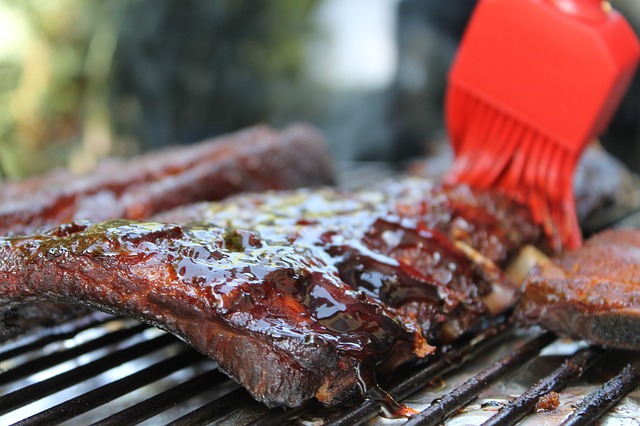Memorial Day Weekend officially kicks off the grilling season. If you’re the grillmaster for your MDW BBQ then you are by far the most important person at the party. You hold the fate of dozens of hot dogs, hamburgers, steaks, brats, sausage, kebabs, and marinaded chicken breasts. If you leave your grilling station for too long you jeopardize charcoaling all those meaty morsels into burnt inedible crisps. There are plenty of pitfalls that could ruin your Memorial Day Weekend barbecue, here are some tips so you are the king of the grill that everyone respects and loves.
- Burgers tend to shrink during grilling, but also blister and plump up in the middle during grilling. Before you slap your burger patties on the grill, make a small indentation in the middle of the burger. This will ensure a perfectly flat hamburger where the toppings are sliding down a small burger hill. Also, don’t pack your burgers too hard otherwise you’ll get a hockey puck of a burger.
- If you’re cooking frozen meats, make sure to let them thaw out. If your meat is not thawed enough you will burn the outside of the meat and it will be uncooked inside. Here is a guide to thawing various meats.
- Did you know that marinating your meat not only gives it a tasty, complex flavor but it also can reduce your risk of cancer. Marinades inhibit the formation of potentially carcinogenic HCAs (heterocyclic amines) that form when grilling “muscle meats” like poultry, red meat, and fish. The American Institute for Cancer Research (AICR) states that marinating can reduce HCA formation by as much as 92% to 99%.
- If you do use a marinade it is best to try to stay away from sugary marinades because sugar burns much quicker than the meat.
- When adding sugary marinades such as barbecue sauce or teriyaki sauce, it is best to add the sauce in the last 10 minutes of grilling.
- Seasoning the ground meat with salt and pepper before you start cooking so that it is full of flavor and has a great texture.
- A clean grill is a tasty grill. The best time to clean the grill is when it is hot so clean off all charred debris after you’re done cooking and after you have preheated your grill.
- Preheat your grill 15 to 25 minutes before you start cooking to make sure it reaches a high enough temperature to kill any bacteria. Your grill should be 400-450°F for high, 350-400°F for medium-high, 300-350°F for medium and 250-300°F for low heat.
- Lean meat will stick to the cooking grid, so soak a paper towel with vegetable oil or olive oil then hold it with tongs and rub it on the rack.
- If you want to avoid flare-ups make sure you select lean cuts of meat, trim excess fat, and remove poultry skins.
- When it comes to burgers though, a little bit of fat goes a long way. For juicy, flavorful burgers you want ground beef that is at least 15% – 20% fat.
- Never press down on the burgers when they are cooking, that only squishes out the tasty juices and dries them out.
- Don’t trust trust your timer or your uncle, the only way to ensure that the meat is cooked thoroughly is with a cooking thermometer.
- Depending on what you are cooking will dictate whether you should open the lid of the grill or have it closed. You wouldn’t be wrong in leaving the lid open for quick-grilling foods such as burgers, thin steaks, chops, or shrimp that are right on the flames so that you still get that tender pink center. However, when grilling thicker steaks, bone-in chicken, or whole roasts you want the lid down so that the rotating hot air cooks the meat quicker and more thoroughly.
- Lightly coat veggies in olive oil before grilling to prevent them from sticking and drying out.
- The easiest way to grill large vegetables such as potatoes and ears of corn is to wrap them in aluminum foil with some butter inside and just throw it on the grill.
- When grilling vegetables they should be grilled near the open flame to give them a smoky flavor, but definitely don’t put them directly on the flames.
- Make sure that you’ve let the steak rest after you have cooked it. Thick cuts of meat need a be left alone for a few minutes, before being served. That time will allow the proteins to firm and helps the meat to seal in all the delicious flavors. The rule of thumb is to let the meat rest for five minutes for every inch of thickness.
- If seasoning your steaks with salt and pepper is not enough flavor for you and you really want a bold flavor you can make a board dressing. Why not kick up your steaks a notch with a chimichurri sauce. Mix olive oil, parsley, oregano, minced garlic, a squeeze of lemon, a dash of red wine vinegar, diced onions, pepper, and salt. Put this sauce on the dressing board, then let the meat rest on the plate several minutes. Flip the meat once. Then cut the meat, and the juices will combine with the board dressing and enhance the taste.
- If you marinate your steaks, pat them dry with a paper towel on both sides. Wet steaks steam and don’t sear. You won’t get that perfect crust.
https://media.giphy.com/media/c11ISnPiRdis8/giphy.gif
[EatingWell/AOL/Chowhound/BHG]
[protected-iframe id=”fb8b6dc64176944fea60d3143784ff66-97886205-93291949″ info=”cdn-images.mailchimp.com/embedcode/slim-10_7.css” ]
